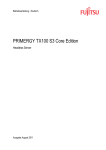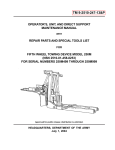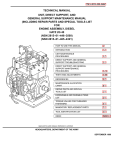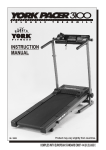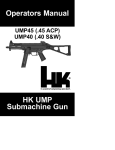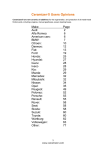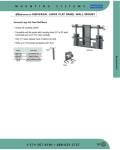Download PWS MK2 Series User Manual
Transcript
PWS MK2 Series User Manual ver 110110 TM 9-PWS-MK2 THIS PAGE INTENTIONALLY LEFT BLANK 1 DO NOT OPERATE YOUR PWS RIFLE PRIOR TO READING THIS MANUAL INTRODUCTION Table of Contents . . . . . Safety . . . . . . . . . . Firearms Use Warning. . . Used Firearm Disclaimer . . . . . . . . . . . . . . . . . . . . . . . . . . . . . . . . . . . . . . . . . . . . . . . . . . . . . . . . . . . . . . . . . . . . . . . . . . . . . . . . . . . . . . . . . . 2 3 . 5 6 CONTROLS AND KEY COMPONENTS MK 2 Series Controls and Key Components . . . . . . . . . . . . . . . . 7 ABOUT US About Us . . . . . . . . . . . . . . . . . . . . . . . . . . . . . . . 9 GENERAL INFORMATION Barrel Life . . . . . . . . . . . . . . . . . . . . . . . . . . . . . . 10 Appearance and Fit . . . . . . . . . . . . . . . . . . . . . . . . . . 10 Modification Warning . . . . . . . . . . . . . . . . . . . . . . . . . 10 CLEANING AND MAINTENANCE Maintenance Warning . . . . . . . . . . . . . . . . . . . . . . . . . 11 Ammo Warning . . . . . . . . . . . . . . . . . . . . . . . . . . . . 11 Cleaning Solvents and Lubricants . . . . . . . . . . . . . . . . . . . . 11 Clearing Procedures . . . . . . . . . . . . . . . . . . . . . . . . . . 12 Weapons Conditions . . . . . . . . . . . . . . . . . . . . . . . . . 12 Disassembling the Weapon . . . . . . . . . . . . . . . . . . . . . . . 13 Cleaning Overview . . . . . . . . . . . . . . . . . . . . . . . . . . 14 Cleaning Your Weapon . . . . . . . . . . . . . . . . . . . . . . . . . 15 Reassembling Your Weapon . . . . . . . . . . . . . . . . . . . . . . 16 TABLE OF CONTENTS LOADING AND UNLOADING The 4 Rules of Firearms Safety . . . . . . . . . . . . . . . . . . . . . 17 Loading and Unloading Your Weapon. . . . . . . . . . . . . . . . . . 18 EXPLODED VIEWS AND PART NUMBERS Upper Parts Numbers . . . . . . . . . . . . . . . . . . . . . . . . . 19 Upper Parts Diagram . . . . . . . . . . . . . . . . . . . . . . . . . 20 Upper Parts Numbers (continued) . . . . . . . . . . . . . . . . . . . 21 Upper Parts Diagram (continued) . . . . . . . . . . . . . . . . . . . . 22 Lower Parts Numbers . . . . . . . . . . . . . . . . . . . . . . . . . 23 Lower Parts Diagram . . . . . . . . . . . . . . . . . . . . . . . . . 24 TROUBLESHOOTING Basic Troubleshooting . . . . . . . . . . . . . . . . . . . . . . . . . 25 SUPPRESSOR USE Suppressor Use Overview . . . . . . . . . . . . . . . . . . . . . . . 27 Suppressor Recommendations. . . . . . . . . . . . . . . . . . . . . 27 NATIONAL FIREARMS ACT WARNING ALL NFA Rules Apply . . . . . . . . . . . . . . . . . . . . . . . . . 28 The National Firearms Act . . . . . . . . . . . . . . . . . . . . . . . 28 Criminal Penalties for NFA Violations . . . . . . . . . . . . . . . . . . 28 WARRANTY Warranty Information . . . . . . . . . . . . . . . . . . . . . . . . . 29 Warranty Return Procedures. . . . . . . . . . . . . . . . . . . . . . 30 2 SAFETY SAFETY IS YOUR NUMBER ONE RESPONSIBILITY! Regardless of where you are the first concern of every firearm owner should be safety. Apply the following safety rules in every situation and with any kind of firearm. If you feel uncertain about any operational aspects of your firearm, please contact Primary Weapons Systems, Inc (PWS) at (208) 344-5217 before proceeding with its operation. WARNING: YOU MUST FOLLOW ALL OF THESE SAFETY RULES TO ENSURE THE SAFE USE OF YOUR FIREARM. FAILURE TO FOLLOW THE INSTRUCTIONS AND WARNINGS IN THIS MANUAL COULD CAUSE SERIOUS PERSONAL INJURY OR DEATH TO YOU OR OTHERS AND DAMAGE TO PROPERTY. As a gun owner, you accept a demanding responsibility and how serious you take this responsibility can be the difference between life and death. There is no excuse for careless or abusive handling of your firearm. Handle your firearm with intense respect for its power and potential danger. ALWAYS KEEP YOUR FIREARM POINTED IN A SAFE DIRECTION Never point a firearm at anyone or anything you do not intend to destroy whether or not it is loaded. This is particularly important when loading, unloading, or field stripping the gun. ALWAYS control the direction of the firearm. ALWAYS TREAT EVERY FIREARM AS IF IT IS LOADED AND WILL FIRE Do not take anyone’s word that the firearm is unloaded – always check for yourself. Never pass your firearm to another person until the cylinder or action is open and you visually check that it is unloaded. Keep your firearm unloaded and safely stored when not in use. NEVER PLACE YOUR FINGER INSIDE THE TRIGGER GUARD OR ON THE TRIGGER UNLESS YOU INTEND TO FIRE Ensure that other objects do not touch the trigger. ALWAYS BE SURE OF YOUR TARGET AND WHAT IS BEYOND IT Always be sure of where the bullet will strike and shoot only where there is a safe back stop free of obstructions, water or other surfaces which can cause ricochets. Be sure your bullet will stop behind your target. Bullets can ricochet and travel in unpredictable directions with considerable velocity. Do not fire randomly into the sky. 3 SAFETY (continued) NEVER CROSS OBSTACLES SUCH AS FENCES OR STREAMS WITH A LOADED FIREARM. Always make certain your firearm is unloaded before crossing a fence, climbing a tree, or negotiating other obstacles. SAFE GUN HANDLING IS YOUR PERSONAL RESPONSIBILITY AT ALL TIMES. Firearms are dangerous and can cause serious injury or death if they are misused or used inappropriately. Safety must be the prime consideration of anyone who owns or handles firearms. Accidents are the result of violating the rules of safe gun handling and common sense. Firearm safety training is available. Contact your firearms dealer, law enforcement agency, local sportsman’s club, etc. for availability. YOU ARE RESPONSIBLE FOR THE FIREARM AT ALL TIMES. In owning a firearm, you must undertake full-time responsibility for your firearm’s safety and security. You must secure firearms safely from children and/or unauthorized users. Your firearm should always be kept unloaded and locked when not in use. A lock has been provided for this purpose. Never assume that the use of this lock is sufficient to safely secure your firearm. You must always evaluate your personal situation and employ the security systems that meet your needs and prevent children and unauthorized users from gaining access to your firearm. NEVER RELY ON MECHANICAL FEATURES ALONE. Only your safe gun-handling habits will ensure the safe use of your firearm. This is your responsibility. ALWAYS SAFELY STORE AND SECURE YOUR FIREARM. Safe and secure storage of your firearm is one of your most important responsibilities. Always secure your firearm and ammunition separately so that they are not accessible to children and/or other unauthorized persons. NEVER KEEP AMMUNITION IN THE SAME LOCATION AS THE FIREARM. Store each in a separate and secure place. IT IS YOUR RESPONSIBILITY TO ENSURE THAT YOU ARE IN COMPLIANCE WITH ALL APPLICABLE LAWS AND ORDINANCES REGARDING THE USE OF YOUR FIREARM. 4 SAFETY (continued) ALWAYS WEAR EYE AND EAR PROTECTION THAT IS SPECIFIED FOR USE WITH FIREARMS Proper protective equipment should be worn every time you handle your firearm for purposes of discharging your firearm or for cleaning and maintenance. Ensure that others in the vicinity of where you are shooting also wear proper ear and eye protection. NEVER USE ALCOHOL OR DRUGS BEFORE OR WHILE SHOOTING Do not use your firearm if you are on any medication which impairs, even slightly, your mental or physical ability. ALWAYS HAVE ADEQUATE VENTILATION Discharging firearms in poorly ventilated areas, cleaning firearms, or handling ammunition may result in exposure to lead and other substances known to cause birth defects, reproductive harm, and other serious physical injury. Review the warnings and labels for all ammunition and cleaning products carefully. Wash hands thoroughly after exposure. BEFORE HANDLING ANY FIREARM, UNDERSTAND ITS OPERATION Not all firearms are the same. Familiarize yourself with the mechanical features of any firearm you intend to use. If you feel uncertain about any operational aspects of your PWS firearm, please contact PWS Customer Service at (208) 344-5217 before proceeding with its operation. NEVER ALLOW A FIREARM TO BE USED BY INDIVIDUALS WHO DO NOT UNDERSTAND ITS SAFE OPERATION OR HAVE NOT READ THESE FIREARM SAFETY RULES ALWAYS USE THE CORRECT AMMUNITION FOR YOUR PARTICULAR FIREARM Never use non-standard, reloaded, or “hand loaded” ammunition which has not been subjected to internal ballistic pressure testing. BEWARE OF BARREL OBSTRUCTIONS Be sure the barrel is clear of obstructions before shooting. Mud, water, snow or other objects may inadvertently lodge in the barrel bore. A small obstruction can cause a dangerous increase in pressure and may damage your weapon and cause injury to yourself and others. BE SURE ALL ACCESSORIES ARE COMPATIBLE Ensure that all accessories such as grips, slings, scopes and other accessories are compatible with the firearm and that the accessories do not interfere with safe operation. It is your responsibility to understand and follow all of the instructions in this manual, as well as those which may be supplied with your ammunition and any accessory. NEVER DISASSEMBLE YOUR FIREARM BEYOND THE FIELD STRIPPING PROCEDURE OUTLINED IN THIS MANUAL Improper disassembly or reassembly of your firearm may be dangerous and can lead to serious injury or death. 5 SAFETY (continued) NEVER MANIPULATE, ADJUST OR CHANGE ANY OF THE INTERNAL COMPONENTS OF YOUR FIREARM UNLESS SPECIFICALLY INSTRUCTED TO DO SO IN THIS MANUAL Improper manipulation of any other internal component may affect the safety and reliability of your firearm and may cause serious injury or death. NEVER ALLOW ANY ALTERATION OR REPLACEMENT OF PARTS IN YOUR PWS FIREARM UNLESS PERFORMED BY A QUALIFIED GUNSMITH Repairs or replacements should only be done by a qualified gunsmith using genuine PWS parts. If you do otherwise, improper functioning of your firearm may occur and serious injury or death and damage to property may result. WARNING: SAFE USE OF A FIREARM IS YOUR PERSONAL RESPONSIBILITY AND THE FAILURE TO FOLLOW ALL OF THESE BASIC SAFETY RULES MAY RESULT IN SEVERE PERSONAL INJURY OR DEATH TO YOU OR OTHERS AND DAMAGE TO PROPERTY. YOU ARE THE MOST IMPORTANT SAFETY DEVICE WHEN IT COMES TO THE USE OF YOUR FIREARM AND PRIMARY WEAPONS SYSTEMS, INC WILL NOT BE RESPONSIBLE FOR ANY PERSONAL INJURY, DEATH OR PROPERTY DAMAGE THAT RESULTS FROM: (1) THE CRIMINAL OR NEGLIGENT USE OF THIS FIREARM; (2) A DISREGARD OF THESE SAFETY INSTRUCTIONS AND WARNINGS; (3) IMPROPER OR CARELESS HANDLING OF THIS FIREARM; (4) THE USE OF NON-STANDARD, DEFECTIVE, IMPROPER OR RELOADED AMMUNITION; OR (5) IMPROPER OR NEGLIGENT MODIFICATIONS OR REPAIRS TO THE FIREARM. USED FIREARM DISCLAIMER: Buyer agrees to have any used firearm checked by a certified gunsmith prior to firing. Buyer assumes all legality, liability and responsibility for the condition, use & security/storage of the firearm purchased. Buyer understands that all firearms are potentially dangerous if handled improperly. Upon purchase, buyer assumes all liability and responsibility including but not limited to the usage and safe storage of the purchased firearm. 6 CONTROLS AND KEY COMPONENTS MK2 Series Carbine Length Rifle Forward Assist Enhanced Buffer Tube Bolt Carrier Trunnion Shell Deflector Gas Block Ejection Port Cover Magazine Well Magazine Release Lower Receiver Trigger Grip 7 CONTROLS AND KEY COMPONENTS (continued) MK2 Series Carbine Length Rifle Charging Handle Top Picatinny Rail* Barrel* Muzzle Device* Upper Receiver Bolt Catch Stock QD Sling Swivel Attachment Side & Bottom Picatinny Rails Trigger Guard Stock Adjustment Latch Selector Switch * Muzzle Device, Top Rail and Barrel length may vary depending on model 8 ABOUT US MISSION Primary Weapons Systems, Inc. (PWS) is a Federally-licensed firearms manufacturer located in Boise, Idaho. Our mission is to provide the highest quality, most reliable, accurate, and durable weapons systems for today’s war-fighter. FOCUS PWS is the designer and manufacturer of the MK1 and MK2 series rifles and uppers in addition to a complete line of flash-suppressing compensators such as the FSC556, SM556, FSC30, and more. PWS develops items based on real world requirements with the goal of redefining accuracy and performance in the piston-driven platforms. With top of the line CNC machine centers, lathes, screw machines, and MIL-Spec coatings all in-house, PWS is able to produce superior products without the enormous overhead of its competitors. Our CNC machines are programmed and operated by true craftsmen who are also shooters. It is this combination that enables us to provide our clients with the highest quality products that are not only aesthetically appealing, but also very functional. GOALS Our goal is to make products which perform better, last longer, require less user maintenance, and provide the best value to the user. While our operating system is proprietary, the proven concept has been around for decades and will continue to be the cleanest, most efficient gas piston system available. Our aim is to create lifelong relationships with our customers who believe in our ideas and the quality of our products. We invite our customers to provide feedback through direct contact as well as through customer reviews on the product pages throughout the website. 9 GENERAL INFORMATION Your firearm is a lightweight, gas piston-operated, air cooled, magazine-fed rifle produced for a high degree of accuracy, reliability, and durability. The firearm’s construction features extensive use of aircraft-grade forgings, CNC-machined components and high-quality barrels. The unique design of this system has numerous benefits over the traditional direct-impingement system, as well as other gas piston-operated SR-25 based platforms. BARREL LIFE Barrel life depends on how fast the rifle is fired and how accurate the shooter insists it must be. Firing the rifle as fast as the trigger can be pulled or sustained full-auto fire can ruin the barrel in just a few hundred rounds. Firing at controlled rates, both semi-auto and burst, will allow your barrel to last for 15,000 to 20,000 rounds with acceptable accuracy levels. As with any quality barrel, a proper barrel break-in will ensure your new PWS product is as accurate as possible and proper maintenance will help your product last much longer. PWS recommends you clean your rifle or upper at least every 1,000 rounds. APPEARANCE AND RECEIVER FIT Your new rifle is not a custom firearm. PWS requires a close fit between the receivers, but normal forging and machining variations may result in play or slight side to side receiver mismatch. This is not a manufacturing defect and has no adverse effect on accuracy or the weapon’s function. All PWS rifles and uppers are test-fired before leaving our facility. New rifles will normally show evidence of this firing. If the receiver looks light or uneven in color, it is most likely dry and a light coat of oil on the metallic surfaces will improve its appearance. The upper and lower receivers are made from forgings because forgings provide superior strength over billet machining processes. By the very nature of a forging, small dents and dings on the outside of the receiver may be visible. No forging is free of them. This is not a defect. WARNING: YOUR PWS FIREARM WAS DESIGNED TO FUNCTION PROPERLY WITH ITS ORIGINAL COMPONENTS. ALTERATIONS TO THE ORIGINAL COMPONENTS OR REPLACEMENT OF THEM WITH AFTERMARKET (NON-PWS MANUFACTURED) COMPONENTS CAN CAUSE MALFUNCTIONS OR EVEN MAKE THE FIREARM UNSAFE. DO NOT ALTER ANY PART OR ADD /SUBSTITUTE PARTS NOT MANUFACTURED BY PRIMARY WEAPONS SYSTEMS, INC. ATTEMPTED CUSTOMIZATION OF YOUR PWS PRODUCT MAY VOID YOUR WARRANTY. 10 CLEANING AND MAINTENANCE WARNING: ALWAYS UNLOAD YOUR FIREARM BEFORE CLEANING, LUBRICATION, DISASSEMBLY, OR REASSEMBLY. WARNING: DO NOT APPLY LUBRICANT OR PRESERVATIVE TO YOUR AMMUNITION. DOING SO MAY CAUSE THE CARTRIDGE TO PARTIALLY MALFUNCTION, LEAVING THE BULLET LODGED IN THE BORE, CREATING A BORE OBSTRUCTION. CLEANING SOLVENTS AND LUBRICANTS Military services generally use a multipurpose chemical called CLP (cleaner, lubricant, and preservative) sold commercially as “Break Free.” Although it is useful if nothing else is available, armament engineers prefer individual, specialized products. High quality cleaning solvents, like Hoppes No. 9, do an excellent job of removing metal fouling from the bore. PWS uses and recommends SLIP 2000, EWL (Extreme Weapon Lubricant) for maximum reliability and service life. Lubricate your rifle (especially the highly stressed bolt and bolt carrier assembly) LIGHTLY with high quality firearms lubricants. Excessive lubricant is not needed and will simply attract dirt in places you do not want it. Under NO conditions should any lubricant containing graphite be used with your rifle. Graphite can encourage rapid corrosion to the aircraft-grade aluminum used in your rifle. In addition to cleaning solvents and lubricants, the basic cleaning equipment you will need includes a cleaning rod, brass bore brush, chamber brush, patches, and other items found in commercially available cleaning kits. PWS uses and recommends Hoppes BoreSnakes. 11 CLEANING AND MAINTENANCE (continued) WARNING: TO BE CONSIDERED SAFE BEFORE DISASSEMBLY, CLEANING, INSPECTING, TRANSPORTING, OR STORING, THE WEAPON MUST BE CLEARED. CLEARING PROCEDURE 1. 2. 3. 4. 5. 6. 7. 8. 9. Point the muzzle in a designated SAFE DIRECTION. Attempt to place selector lever on SAFE (If weapon is not cocked, lever cannot be placed on SAFE). Remove the magazine by depressing the magazine catch button and pulling the magazine down. Lock the bolt open by pull the charging handle rearward while pressing the bottom of bolt catch. Ensuring the bolt carrier group is locked rearward, return the charging handle to full forward position. If you have not done so before, place the selector lever on SAFE. Visually (not physically) inspect the receiver and chamber to ensure these areas contain no ammo. Drop the bolt closed. Close the ejection port cover. WEAPON CONDITIONS Condition 4 - Weapon on safe, bolt home on an empty chamber, no magazine inserted, ejection port cover closed Condition 3 - Weapon on safe, bolt home on an empty chamber, magazine inserted, ejection port cover closed Condition 2 - APPLIES ONLY TO WEAPONS WITH EXTERNAL HAMMERS - DOES NOT APPLY TO THE M4/AR15 PLATFORM Condition 1 - Weapon on safe, round in chamber, bolt home, magazine inserted, ejection port cover closed 12 CLEANING AND MAINTENANCE (continued) DISASSEMBLING THE WEAPON 1. 2. 3. 4. 5. 6. 7. Place the weapon in condition 4. Remove the sling or other peripherals if applicable. Push in on the take down pin (left to right) as far as it will go, allowing the upper receiver to pivot away from the lower receiver. Push the receiver pivot pin. Separate the upper and lower receivers. Pull back the charging handle and bolt carrier. Remove the bolt carrier group. UNLESS REPLACEMENT IS REQUIRED, THE CHARGING HANDLE SHOULD NOT BE REMOVED FROM THE BOLT CARRIER GROUP. 8. 9. 10. 11. 12. 13. 14. 15. 16. 17. Remove the firing pin retaining pin. DO NOT OPEN OR CLOSE SPLIT END OF PIN. Place the bolt assembly in the locked position. PUSH IN. Drop the firing pin out of the rear of the bolt carrier. Remove the bolt cam pin. TURN CAM 90 DEGREES AND LIFT OUT. Remove the bolt from carrier. Remove the spring from the back of the piston bolt. Use the firing pin to push out the extractor pin. Note: Press the rear of the extractor to check the spring function. Remove the extractor and spring. Press in buffer, depress the retainer, and release the buffer. Remove the buffer and the action spring. NO FURTHER DISASSEMBLY IS REQUIRED. 13 CLEANING AND MAINTENANCE (continued) OVERVIEW Military weapons demand better cleaning attention than sporting firearms. The receiver, locking lugs and chamber are more important than the entire length of the bore. If you cannot get the bolt open or a shell into the firearm, it becomes useless. A brush does not clean a weapon; it only loosens the powder residue, copper and dirt. A tight patch is essential to mop out these critical areas. While the long-stroke gas piston system of the PWS MK1 & MK2 series rifles will greatly reduce carbon buildup, it is still a good idea to maintain your weapon in a manner that corresponds with this type of weapon. The locking lugs are the most important area to clean on the weapon. Loose powder residue builds up in the recess in front of the lugs. This buildup may bind the bolt and prevent it from cycling smoothly. This is a progressive cleaning area in that the loose residue in this area will eventually pack if not removed. One cause of buildup in the locking lugs is incorrect cleaning. Pulling a brush backwards through the barrel toward the chamber will whip bristles backwards and catapult the dirt into the recess behind the lugs. The chamber must be kept clean to allow easy extraction of the empty shell. If scratches are present, the case fire forms into these recesses and prevents the case from extracting. It is normal to get a gummy residue buildup at the chamber shoulder. This is loosened with the chamber brush and mopped out with a rotating swab. The neck and shoulder of the chamber is cleaned by rotating the bore brush and swab before the bore is cleaned. Powder residue buildup in the neck will trap the bullet causing late release times and resulting in stuck cases. The bore should only be cleaned in the direction of the bullet. Allowing abrasive dirt from the muzzle into the chamber and neck area will allow the bullet to drag it down the bore during operation. This will cause premature throat erosion and seriously diminish barrel life. The crown of the muzzle gives a bullet its final direction. You should take measures to protect the crown of your barrel. 14 CLEANING AND MAINTENANCE (continued) CLEANING YOUR WEAPON Begin by wiping any dust and debris off of the outside of the rifle with a brush. A barber or half-inch paintbrush is ideal for this. Use a toothbrush or cotton swabs for the areas around the trigger and sights. Spray the length of exposed barrel with a cleaning agent. You can use a toothbrush to scrub underneath the rails. The rails should not be removed for normal maintenance and cleaning. Wipe down the bolt, bolt carrier and extractor thoroughly. Use cotton swabs to clean the grooves on the front and the bolt face. If necessary use a scraper tool to clean off all carbon deposits on the bolt face. Push a barrel brush through the breech to the flash suppressor. It is important that you only push things through the barrel in the direction that the bullet travels. Repeat this step as many times as necessary - five to ten times for light cleaning, up to 30 times for a GI standard cleaning. Run a small arms barrel swab through the barrel in the same manner. Be sure to use a clean swab for each pass. Keep doing this until the swab comes out clean. Clean the breech or “star chamber” with cotton swabs and a scraper tool. Wrap a small piece of rag around a toothbrush to scrub the inside of the upper receiver. Wipe down the buffer and buffer spring with a clean rag. Clean the trigger mechanism with cotton swabs and a small brush. Squirting gun oil approved for this purpose into the trigger mechanism helps loosen dirt in this intricate little part. Although we do not recommend the use of harsh chemicals such as brake cleaner, if you insist on using this type of product, ensure that you thoroughly re-lubricate the inside and outside of your weapon with a multi-purpose product such as Rem-Oil, Militec-1 or similar. 15 CLEANING AND MAINTENANCE (continued) REASSEMBLING THE WEAPON 1. 2. 3. 4. 5. 6. 7. 8. 9. 10. 11. 12. 13. 14. 15. 16. 17. Set the extractor back in its groove. Compress the extractor spring by pushing down on the extractor. Slip the retaining pin into the hole and push inward until even with the sides of the bolt. Slide the piston bolt spring over the shaft of the bolt. Push the bolt into the bolt assembly. Be sure that the extractor is on the right side of the assembly so the cam pin will fit in. Place the cam pin into the bolt assembly, then turn it 90 degrees. Guide the firing pin gently into the bolt through the back of the assembly. Insert the firing pin retaining pin into the bolt assembly. Pull the bolt all the way forward. It has to be in this position so the cam pin will fit into the upper receiver. Slide the charging handle all the way forward until it stops against the carrier key portion of the operating rod. (fig 1) Guide the piston operating rod toward rear of the piston tube. (fig 2) Slide the lug portion of the charging handle into the receiver groove. (fig 3) Slide the buffer spring and buffer into the buffer tube until they are locked in place by the buffer retaining pin. Place the upper and lower receivers together Push the take-down pins in place. It is easiest to do the front pin first and the rear pin second. fig. 1 fig. 2 fig. 3 16 FOUR RULES OF FIREARM SAFETY READ AND UNDERSTAND THESE RULES BEFORE LOADING YOUR WEAPON THE FOUR RULES OF FIREARM SAFETY 1. Treat all guns as if they are loaded. Whether or not you are certain the weapon is not loaded, you should treat it as if it were. Never point an “empty” firearm at something you do not wish to destroy. 2. Never let the muzzle of a gun point at anything you do not want to destroy or kill. It should be understood that this rule applies to the shooter as well. Be cognizant of the muzzle and what it is pointing at including your feet and legs and those of others around you. Never allow your muzzle to cross (flag) an object that you do not wish to destroy. 3. Keep your finger straight and off the trigger. This is a paramount rule of firearm safety. Your finger should not enter the trigger guard until your sights are on a target that you intend to destroy. 4. Be absolutely sure of your target and its surroundings. Be aware of not only your target, but what it behind and around your target. Bullets can ricochet, penetrate through, and fall from the sky at velocities just as deadly as when the bullet left the barrel. 17 LOADING AND UNLOADING (continued) LOADING YOUR WEAPON 1. 2. 3. 4. 5. 6. 7. With hammer cocked, ensure the selector lever is on safe. Open bolt and check the chamber – the chamber should be clear. Insert a magazine into the magazine well, pushing upwards firmly until the magazine is seated. Pull downward on the magazine to ensure the magazine is locked in place. Push the top of the bolt catch. Tap the forward assist to ensure the bolt is completely in battery. Close the ejection port cover. UNLOADING (CLEARING) YOUR WEAPON 1. 2. 3. 4. 5. 6. 7. 8. 9. Ensure the selector lever is on SAFE. Point the muzzle in a designated SAFE DIRECTION. Remove the magazine by depressing the magazine catch button and pulling the magazine down. Lock the bolt open by pulling the charging handle rearward while pressing the bottom of bolt catch. Observe the live round ejecting from the chamber via the ejection port. Ensuring the bolt carrier group is locked rearward, return the charging handle to full forward position. Visually (not physically) inspect the receiver and chamber to ensure these areas contain no ammo. Drop the bolt closed. Close the ejection port cover. 18 EXPLODED VIEWS AND PART NUMBERS ITEM # 19 NOMENCLATURE PART NUMBER 01 RECEIVER, CARTRIDGE (M4 AND M4A1) PWS_MK2_UR_SID 02 HANDLE, CHARGING BCM_GFH_MOD_3_762 03 ROD, OPERATING PWS_MK2_0R_01 04 PISTON, DUAL HEAD PWS_MK2_PISTON_DH 05 TUBE, PISTON, MK2 PWS_TUBE_MK2 06 BARREL AND BARREL EXTENSION ASSEMBLY, 1:10 TWIST PWS_MK2xx_BL_110 07 CARRIER, BOLT, MK2, ENHANCED PWS_MK2_EBC_01 Not shown WEIGHT, CARRIER, MK2 PWS_MK2_CW_xx not shown CLIP, RETAINING, CARRIER PWS_MK2_CRC 08 PIN, FIRING, MK2 PWS_MK2_308_BT_14 09 PIN,FIRING PIN RETAINING, MK2 PWS_MK2_308_BT_16 10 BOLT, BREACH, ENHANCED, MK2 PWS_MK2_EB_762_01 11 SPRING ASSEMBLY, EXTRACTOR, MK2 PWS_MK2_ 308_BT_07 12 EXTRACTOR, CARTRIDGE, MK2 PWS_MK2_308_BT_03 13 PIN, SPRING, EJECTOR, MK2 PWS_MK2_308_BT_08 14 PIN, EXTRACTOR, MK2 PWS_MK2_308_BT_03 15 SPRING, HELICAL, COMPRESSION, MK2 PWS_MK2_308_BT_05 16 EJECTOR,CARTRIDGE, MK2 PWS_MK2_ 308_BT_04 17 PIN, GROOVED, HEADED BOLT CAM, MK2 PWS_MK2_308_BT_17 NOTES xx in MK2xx indicates barrel length xx in CW-xx indicates weight in ounces EXPLODED VIEWS AND PART NUMBERS (continued) 02 03 04 09 07 05 17 01 15 08 12 13 14 16 11 10 06 20 EXPLODED VIEWS AND PART NUMBERS ITEM # 18 21 TRUNNION, STANDARD, MK2 NOMENCLATURE PART NUMBER PWS_MK1_TRUN_01 19 NUT, RETENTION, BARREL, MK2 PWS_MK1_BL_RET_NUT 20 BLOCK, GAS, MK2 PWS_MK1_BLK_GAS_02 21 PIN, PLAIN, TAPERED NSN 5315-01-502-0002 22 SCREW, RAIL, RETENTION, 10-32X1/4” PWS_SH_1032_14 23 RAIL, TOP, CARBINE, MK2 PWS_RL_TP_MK2 24 RAIL, SIDE, CARBINE PWS_RLS_B_MK2 25 SHIM, COMPENSATOR, SET, 5/8” PWS_SHIM_308 26 SCREW, CARRIER NSN 5305009927284 27 CLIP, C, 1/2” PWS_CC_12 NOTES EXPLODED VIEWS AND PART NUMBERS (continued) 26 23 22 24 27 22 21 18 19 20 24 27 25 22 22 27 22 EXPLODED VIEWS AND PART NUMBERS (cont) ITEM # 23 NOMENCLATURE PART NUMBER 01 PWS MK2 LOWER RECEIVER PWS_MK2_Rec 02 BUFFER TUBE, ENHANCED, PWS PWS_EBT 03 PLATE, BUFFER TUBE PWS_EBT_Plate 04 BUFFER SPRING, MK2 PWS_308_CS_10A 05 BUFFER ASSEMBLY, CARBINE, MK2 PWS_308_CS_10B 06 MOE® Carbine Stock – Mil-Spec Model MAGPUL_MOE_STOCK_MS_BLK 07 PIN, STRAIGHT, HEADLESS NSN 5315-00-992-6654 08 SPRING, HELICAL, COMP COMPRESSION NSN 5360-00-992-6655 09 DETENT, SAFETY NSN 1005-00-992-6667 10 SPRING, HELICAL, COMP SAFETY NSN 5360-00-992-7292 11 MAGPUL MOE® GRIP MAGPUL_MOE_GRIP_BLK 12 PIN, GROOVED, HEADED (TAKE DOWN) PWS_308_LR_30 13 PIN, GROOVED, HEADED (PIVOT PIN) PWS_308_LR_18 14 CATCH, MAGAZINE NSN 1005-00-056-2201 15 SPRING, HELICAL, COMP COMPRESSION, MAGAZINE CATCH NSN 5360-00-992-7301 16 BUTTON, MAGAZINE CAT CATCH NSN 1005-00-992-7302 17 CATCH, BOLT, MK2 PWS_308_LR_11 18 PLUNGER, BOLT CATCH NSN 1005-00-056-2247 19 SPRING, HELICAL, COMP COMPRESSION, BOLT CATCH NSN 5360-00-056-2246 20 SCREW, BOLT CATCH PWS_308_LR_12 21 HAMMER, FIRING, SMALL NSN 1005-00-017-9551 22 PIN, GROOVED, HEADLES TRIGGER AND HAMMER NSN 5315-00-992-7309 23 SPRING, HELICAL, COMP DISCONNECT NSN 5360-01-396-0256 24 DISCONNECTOR NSN 1005-00-999-0406 25 SELECTOR, FIRE CONTROL NSN 5340-01-225-8339 26 TRIGGER NSN 1005-00-992-7307 27 PIN, SHOULDER, HEADLE BUFFER RETAINER NSN 5315-00-992-6651 28 SPRING, HELICAL, COMP COMPRESSION BUFFER RETAINER NSN 5360-00-992-6652 NOTES EXPLODED VIEWS AND PART NUMBERS (continued) 21 04 5 24 25 27 22 17 28 23 02 03 18 20 07 26 12 9 15 08 14 16 11 01 09 06 10 13 24 TROUBLE SHOOTING PROBLEM WEAPON WILL NOT FIRE BOLT WON’T UNLOCK WON’T EXTRACT WON’T FEED 25 POSSIBLE CAUSE CORRECTION SELECTOR LEVER ON SAFE ROTATE SELECTOR LEVER TO SEMI OR AUTO IMPROPER ASSEMBLY OF FIRING PIN ASSEMBLE CORRECTLY, ENSURING THE RETAINING PIN IS BEHIND THE LARGE SHOULDER OF THE FIRING PIN EXCESSIVE OIL IN FIRING PIN RECESS CLEAN OUT WITH PIPE CLEANER - DO NOT OVER LUBRICATE DEFECTIVE AMMO REMOVE AND DISCARD AMMO BUILDUP ON FIRING PIN OR BOLT FACE CLEAN YOUR WEAPON DIRTY BOLT LUGS OR EXTENSION CLEAN YOUR WEAPON BOLT LUGS BURRED OR BOLT BROKEN CONTACT PWS CUSTOMER SERVICE OR YOUR UNIT ARMORER BROKEN EXTRACTOR SPRING OR EXTRACTOR CONTACT ARMORER TO HAVE REPLACED DIRTY OR CORRODED AMMO CLEAR WEAPON FOLLOWING CLEARING PROCEDURES - PUSH OUT EMPTY CASING WITH CLEANING ROD CARBON OR DEBRIS IN CHAMBER CLEAN CHAMBER FOULING IN EXTRACTOR RECESS OR LIP CLEAN THE EXTRACTOR DIRTY OR CORRODED AMMO CLEAN OR DISCARD AMMO DIRTY OR DEFECTIVE MAGAZINE CLEAN OR REPLACE MAGAZINE TOO MANY ROUNDS IN MAGAZINE REMOVE EXCESS ROUNDS ACTION OF BUFFER ASSEMBLY IS RESTRICTED TAKE OUT BUFFER AND SPRING AND CLEAN MAGAZINE NOT FULLY SEATED RE-SEAT MAGAZINE TROUBLE SHOOTING (continued) PROBLEM WON’T CHAMBER POSSIBLE CAUSE CORRECTION DIRTY, DAMAGED OR CORRODED AMMO CLEAN OR REPLACE CARBON OR DEBRIS IN CHAMBER CLEAN CHAMBER DIRTY BARREL LOCKING LUGS CLEAN LUGS DOUBLE FEED DEFECTIVE MAGAZINE REPLACE MAGAZINE WON’T EXTRACT FROZEN EXTRACTOR REMOVE AND CLEAN RESTRICTED BUFFER ASSEMBLY REMOVE AND CLEAN RESTRICTED MOVEMENT OF CARRIER GROUP REMOVE, CLEAN AND LUBE (DO NOT OVER LUBRICATE YOUR WEAPON) SHORT RECOIL (SHORT STROKE) CARBON OR DIRT BUILDUP ON CARRIER CLEAN YOUR WEAPON EXCESSIVE WEIGHT BUFFER RETURN TO FACTORY CONFIGURATION OR CONTACT PWS CUSTOMER SERVICE BOLT FAILS TO LOCK AFTER LAST ROUND DIRTY OR CORRODED BOLT SELECTOR LEVER BINDS CLEAN YOUR WEAPON EXCESSIVE WEIGHT SPRING RETURN TO FACTORY CONFIGURATION OR CONTACT PWS CUSTOMER SERVICE FAULTY MAGAZINE REPLACE MAGAZINE DIRT OF SAND UNDER TRIGGER CLEAN YOUR WEAPON 26 Suppressor Use SUPPRESSOR USE OVERVIEW When utilizing a suppressor, often referred to as a silencer, the following information should be noted: • • • • • • • • Use a suppressor designed for the same caliber of weapon Ensure suppressor is firmly attached prior to use The weapon’s rate of fire and felt recoil may increase While gas piston systems greatly reduce the amount of gas and debris, a notable increase may occur depending on the manufacturer Due to the aforementioned increase, the amount of cleaning required may also increase A heavier spring and/or buffer may be required; this combination may not work when using the rifle without the suppressor attached Always follow the manufacturer’s instructions for mounting and dismounting suppressor as well as care and use PWS will not be responsible for damage to your suppressor due to improper use, care or maintenance SUPPRESSOR RECOMMENDATIONS While suppressors become increasingly popular with both military and civilian enthusiasts alike, numerous small companies will continue to rise and fall. PWS recommends only using suppressors manufactured by companies with a proven history of both performance and customer service. 27 NATIONAL FIREARMS ACT WARNINGS ALL NFA RULES APPLY Regarding ownership of any firearm, the buyer has complete responsibility to ensure he/she is in full compliance with all applicable local, state and federal laws regarding possession of said firearm(s). THE NATIONAL FIREARMS ACT The National Firearms Act (“NFA”), 73rd Congress, Sess. 2, ch. 757, 48 Stat. 1236, enacted on 26 June 1934, currently codified and amended as 26 U.S.C. ch. 53, is an Act of Congress that, in general, imposes a statutory excise tax on the manufacture and transfer of certain firearms and mandates the registration of those firearms. The Act was passed shortly after the repeal of Prohibition. The NFA is also referred to as Title II of the federal firearms laws. The Gun Control Act of 1968 (“GCA”) is Title I. All transfers of ownership of registered NFA firearms must be done through the federal NFA registry. The NFA also requires that transport of NFA firearms across state lines by the owner must be reported to the ATF. CRIMINAL PENALTIES FOR NFA VIOLATIONS Violations of the Act are punishable by up to 10 years in federal prison and forfeiture of all devices or firearms in violation, and the individual’s right to own or possess firearms in the future. The Act provides for a penalty of $10,000 for certain violations. A willful attempt to evade or defeat a tax imposed by the Act is a felony punishable by up to five years in prison and a $100,000 fine ($500,000 in the case of a corporation or trust), under the general tax evasion statute. For an individual, the felony fine of $100,000 for tax evasion could also be imposed. 28 WARRANTY INFORMATION PWS LIMITED WARRANTY This product is warranted to be free of defects in material and workmanship for a period of 2 years from the date of purchase. At Primary Weapons Systems’ option, the defective product will be repaired, replaced or substituted with a product of equal value. For warranty service, call Primary Weapons Systems at (208) 344-5217 extension 8. PRIMARY WEAPONS SYSTEMS, INC SHALL IN NO EVENT BE LIABLE FOR ANY INCIDENTAL OR CONSEQUENTIAL DAMAGES. Some states do not allow the exclusion or limitation of incidental or consequential damages, so the above exclusion may not apply to you. This warranty gives you specific legal rights, and you may also have other rights, which may vary from state to state. Primary Weapons Systems, Inc will not be responsible for damage of your firearm caused by: • Failure to provide proper care and maintenance • Accidents, abuse or misuse • Barrel obstruction • Hand-loaded, reloaded or improper ammunition • Unauthorized adjustments, repairs or modifications • Use of ammo that does not fall within the parameters set by SAAMI • Normal wear and tear Before seeking warranty service, please refer to the troubleshooting guide in this manual to attempt to solve the problem. Perform all instructed maintenance and assure that ammunition and magazines are correct and in good condition. Shop rates plus the cost of return shipping will be applied if no covered defect is found. 29 WARRANTY RETURN PROCEDURES Returns for any reason will NOT be accepted without a Return Merchandise Authorization (RMA) number issued by PWS. Please call (208) 344-5217 extension 8 to receive your RMA number. After you receive your RMA number, print it on the outside of the box and include a copy of the RMA paperwork that you receive from PWS. Send your item and completed RMA request to: PWS Attn: Warranty Service 800 E. Citation Court Suite E, Boise, ID 83716 Shipping to and from PWS is the owner’s responsibility, except that PWS will return the firearm to the customer, shipping prepaid, if the return was covered under warranty. Remove any accessories (scope, scope mount, sling, sights, bipods, cleaning equipment, etc) that do not pertain to your problems before you send the firearm in. PWS will not be responsible for lost or damaged accessories sent with returned rifles or uppers. If you have any functional problem with the firearm, do send the magazines with it. Firearms that you wish to return for warranty or out-of-warranty repair may be returned directly to PWS. Non-warranty repairs will be billed at PWS’ shop rates, as will work on firearms submitted with no warranty problem existing. 30 PWS :: 800 E. Citation Court :: Suite E :: Boise, ID :: 83716 (208) 344-5217 www.primaryweapons.com




































